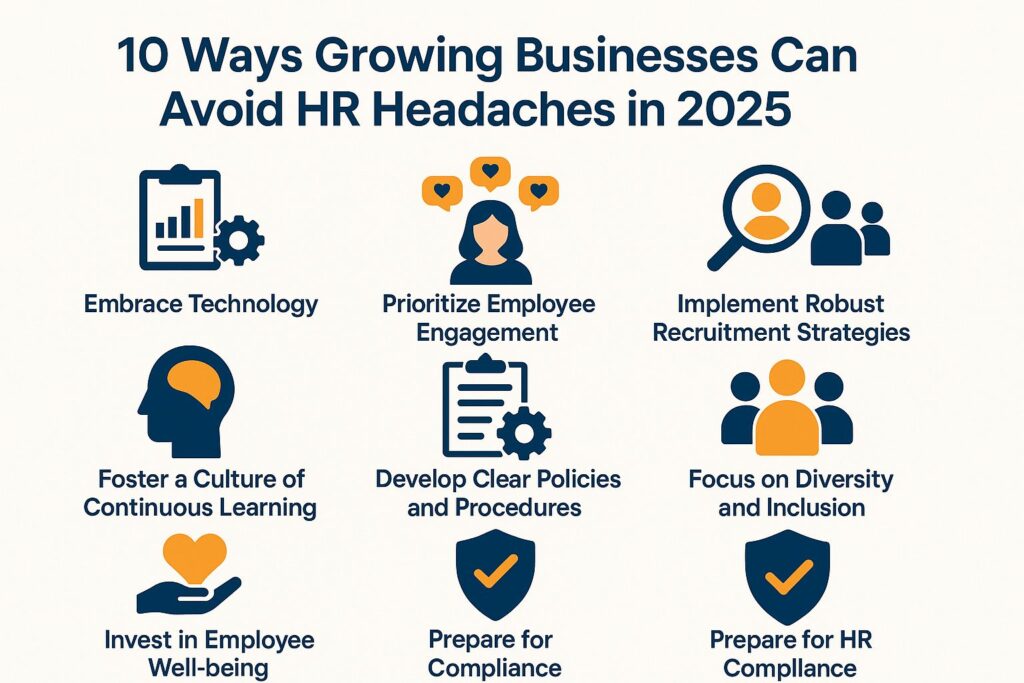
10 Ways Growing Businesses Can Avoid HR Headaches in 2025
HR challenges can derail your growing business faster than you think. As you get ready for 2025, it’s important to know how to steer clear of these usual errors. From embracing technology to prioritizing employee well-being, this guide reveals ten essential strategies. Learn how to make hiring easier, build strong involvement, and meet all rules-while making a successful workplace. Avoid HR problems and make the most of your business!
The Importance of Effective HR Management and Strategic Workforce Planning
Effective HR management directly influences employee engagement and organizational performance, impacting turnover rates substantially.
By using strong HR strategies and practices in workforce analytics, companies can often decrease staff turnover by 20% or more.
Regular employee feedback meetings improve communication and increase job satisfaction. Tools like SurveyMonkey or TINYpulse can make this process more efficient.
Offering professional development opportunities and succession planning leads to higher retention; organizations that invest in training report a 50% lower turnover.
Establishing clear compliance policies further protects the business, with metrics showing organizations that prioritize HR management can avoid costly legal issues, saving thousands annually. For more insights into effective strategies, take a deep dive into our comprehensive guide on HR Management to simplify business operations.
Overview of Common HR Headaches
HR professionals often face headaches ranging from compliance issues to ineffective onboarding processes, which can jeopardize business growth.
Common challenges include:
- Compliance Issues – About 40% of companies find it hard to stay updated with constantly changing regulations.
- Ineffective Onboarding – Nearly 30% report that their onboarding process fails to engage new hires effectively.
- Employee Retention – With turnover costs averaging 21% of annual salaries, this remains a significant concern for 25% of firms.
- Performance Management – 35% cite difficulties in aligning employee goals with business objectives.
Dealing with these problems needs specific approaches, such as putting money into compliance training and improving onboarding by adding mentorship programs.
1. Use Technology for HR Tasks and Make Use of Human Resources Tools
Using technology for HR tasks can simplify payroll and benefits management and make them more accurate.

Automating Payroll and Benefits
Automating payroll processes can reduce processing time from 8 hours to just 2 hours weekly, minimizing errors and ensuring compliance.
To implement payroll automation, consider tools like Gusto, which starts at $39/month plus $6 per employee, and ADP, which offers custom pricing based on business needs.
Start by gathering your employee data and business structure to simplify the setup. During data migration, make sure payroll history is correctly transferred to prevent errors.
Don’t overlook the potential challenges, such as training your team on the new system and integrating it with existing HR software. With a solid plan, using technology can make managing your payroll tasks easier.
Utilizing HR Management Software
HR software such as BambooHR ($99/month) can organize employee details and simplify performance management tasks.
It makes hiring better by sharing job listings on many websites, which increases exposure a lot. For example, companies using BambooHR reported a 30% reduction in time-to-hire through its integrated applicant tracking system.
It also facilitates communication via built-in messaging features, encouraging real-time collaboration. HR managers can simply monitor employee progress through customized performance reviews.
Many organizations, like Acme Corp, have adopted such software to achieve a more organized approach to HR, resulting in higher employee satisfaction and retention rates.
2. Prioritize Employee Engagement
Focusing on employee involvement creates a motivated team, which results in higher productivity and fewer people leaving their jobs. To further enhance your HR strategies, consider exploring how data-driven HR practices can support your employee engagement initiatives.
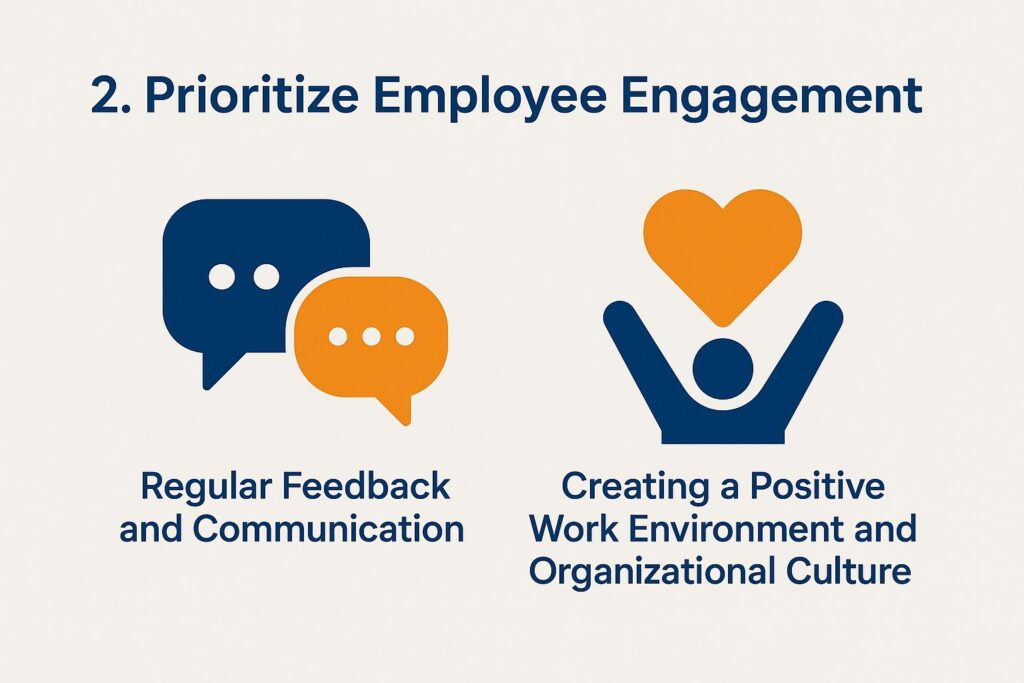
Regular Feedback and Communication
Setting up regular feedback sessions can increase employee happiness by 30% and encourage open communication within teams.
- Start by utilizing tools like Officevibe or TinyPulse for pulse surveys, allowing employees to provide quick, anonymous feedback at least once a month.
- Pair these surveys with regular one-on-one check-ins, which can deepen the dialogue and clarify any concerns.
- Create an open channel for suggestions, perhaps through a dedicated Slack channel or an anonymous drop box.
This method encourages involvement and makes employees feel appreciated and listened to, improving the mood in the workplace.
Creating a Positive Work Environment and Organizational Culture
A positive workplace can increase productivity by 31%, so HR managers should focus on workplace culture.
To create such a workplace, think about starting health programs like fitness competitions or mindfulness workshops, similar to Google’s programs for their employees.
Flexible work setups, like working from home and adjustable hours, can also greatly improve job satisfaction and support work-life balance.
Encourage regular feedback through short surveys, allowing employees to voice their needs.
Organizing team events like monthly outings or group projects can strengthen relationships, increase teamwork, and lift spirits.
These efforts make employees happier and lead to more involvement and new ideas.
3. Implement Robust Recruitment Strategies
Good hiring plans are essential for attracting talented employees and building a positive company reputation in tough job markets.
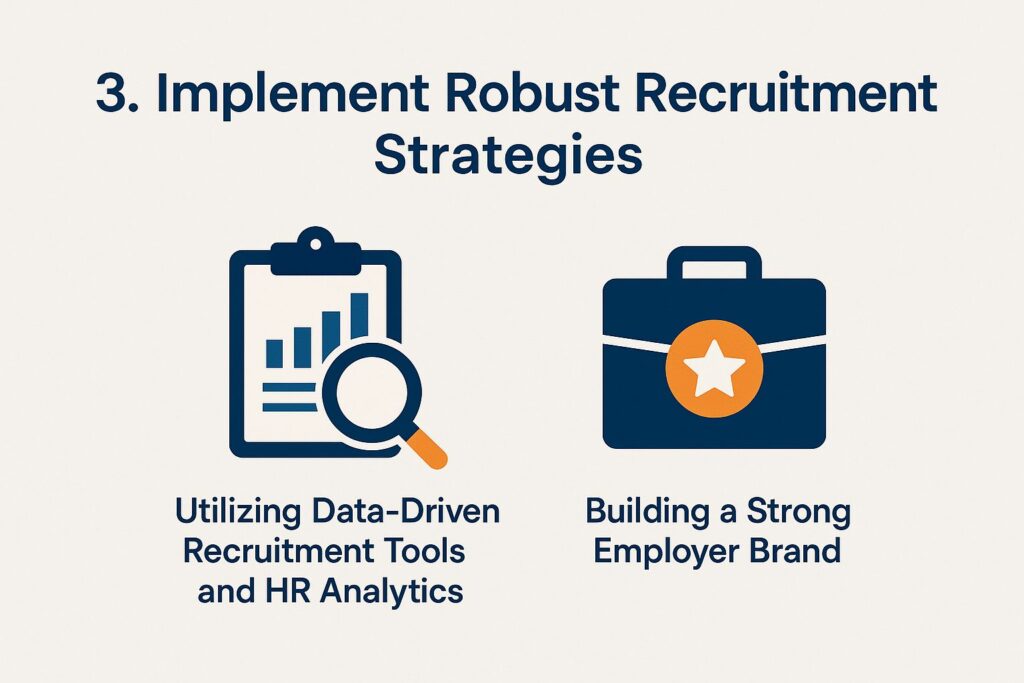
Utilizing Data-Driven Recruitment Tools and HR Analytics
Data-driven recruitment tools like Greenhouse ($6,000/year) allow companies to make informed hiring decisions, improving candidate quality.
To set up an Applicant Tracking System (ATS) such as Greenhouse, begin by linking it with your HR software to make the hiring process more efficient.
Use analytics features to track key recruitment metrics such as time-to-hire, source effectiveness, and recruiting metrics.
For example, companies like Airbnb have used Greenhouse to cut their hiring time by 20%, using information to find the most effective job boards.
Regularly check these metrics to improve your strategies and build a better talent pipeline.
Building a Strong Employer Brand
Having a good reputation as an employer can increase job applications by 50%, which is important for attracting qualified candidates.
To improve employer branding, companies should do two main things: build a strong social media presence and start employee advocacy programs.
Active social media pages, showcasing company culture and values, can significantly engage potential candidates. For example, posting employee testimonials on platforms like LinkedIn or Instagram can humanize your brand.
Employee advocacy programs encourage staff to share company achievements, which helps expand the audience-companies with active employee advocates experience a 30% lower turnover rate.
By investing in these areas, companies can attract talented employees and create a positive workplace reputation.
4. Foster a Culture of Continuous Learning
Promoting continuous learning can improve employee performance by up to 70%, highlighting its significance in HR strategies. For those interested in how these strategies fit into broader business operations, our guide on HR Management offers practical insights.
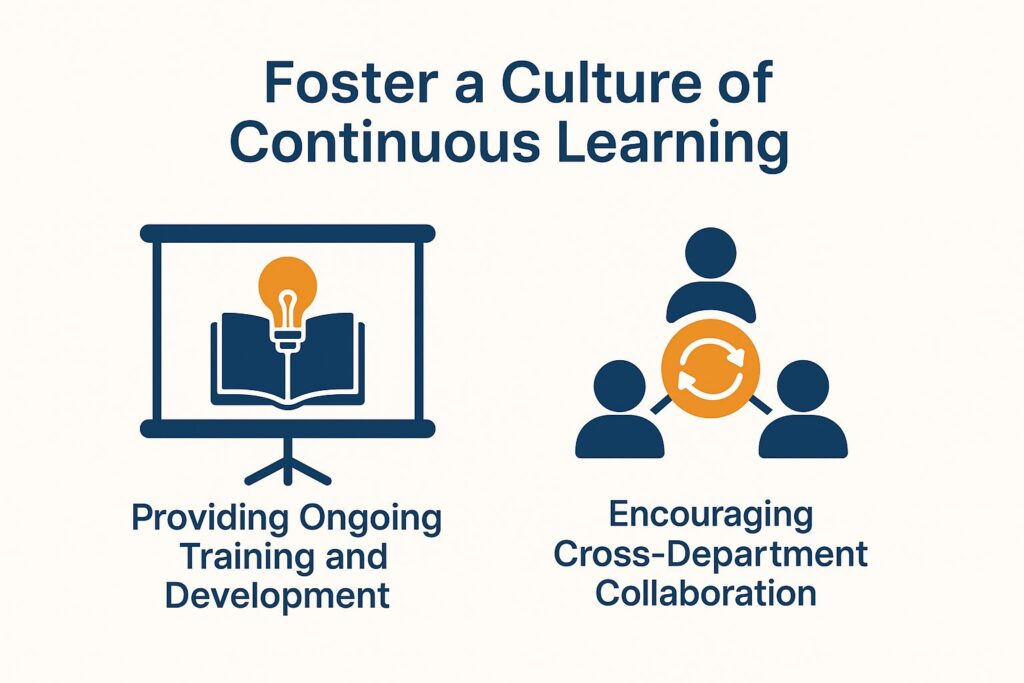
Providing Ongoing Training and Development
Offering regular training through platforms like LinkedIn Learning ($29.99/month) helps employees stay informed about industry trends.
Other effective training options include Coursera, which offers a wide range of courses from top universities, ideal for upskilling employees in specific areas.
For hands-on practice, platforms like Udemy ($9.99-$199.99) provide practical, skills-focused content.
Think about setting up in-house training meetings, where employees can share what they learned from these courses, creating a team-focused learning setting.
Implementing a blended approach-combining online courses with live sessions-can maximize engagement and retention of new knowledge.
Promoting Cooperation Between Departments to Improve Teamwork
Working together across different departments can cut project time by 25%, leading to new ideas and better teamwork.
To facilitate this, implement tools like Slack for real-time communication, where team members can create channels specific to projects.
Using Microsoft Teams lets you have video calls, which makes talking remotely simple.
Regular team-building activities, whether virtual games or face-to-face outings, strengthen interpersonal relationships and improve employee communication.
Schedule meetings every two weeks to check progress and exchange information between departments.
This organized method improves communication and builds a team-focused environment, which can greatly speed up project timelines.
5. Develop Clear Policies and Procedures
Creating clear HR guidelines and rules is necessary for following laws and keeping the workplace fair.
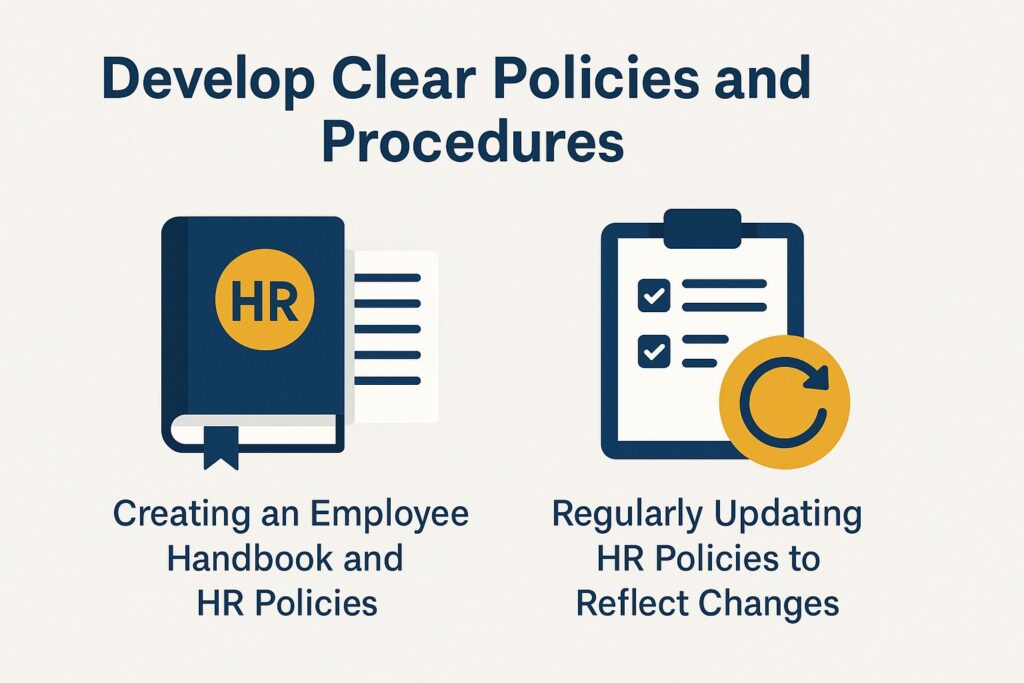
Creating an Employee Handbook and HR Policies
A detailed employee handbook can cut onboarding time in half and explain workplace expectations clearly.
To create an effective employee handbook, start by including essential sections such as company history, mission and values, and workplace policies.
Outline procedures for attendance, dress codes, and performance evaluations. Make sure you follow legal rules, such as labor laws and regulations against discrimination and health and safety rules.
Tools like Gusto or BambooHR can help create templates and track compliance.
It’s important to update your handbook regularly. Review it annually or when there are significant policy changes. Include important people in the review to get their feedback and ideas.
Regularly Updating HR Policies to Reflect Changes
Updating HR policies regularly helps comply with labor laws and avoids expensive legal problems stemming from old procedures.
Schedule a review twice a year to remain compliant. When there are changes in labor laws or current rules, make sure to adjust policies quickly.
Areas to monitor include:
- Employee classification and talent acquisition
- Remote work policies
- Paid leave regulations
Programs such as PolicyMedical or Gensuite can make document management easier, ensuring every employee can find the latest updates. Address changes in employment law within 30 days to stay compliant and mitigate risks effectively.
6. Focus on Diversity and Inclusion
Paying attention to diversity and ensuring everyone feels part of the team can increase team performance by 35%, which is an important part of HR strategies. This improvement is one of the many reasons why strong HR management is crucial for business success.

Implementing Inclusive Hiring Practices
Implementing inclusive hiring practices can improve workforce diversity by 20%, enhancing creativity and innovation within teams.
Use tools like Textio to write fair job descriptions that attract a wide range of applicants, enhancing talent management.
Next, form diverse interview panels to mitigate groupthink and promote inclusivity; include individuals from various backgrounds and departments.
To check how you’re doing, use Jobvite’s analytics tools to watch diversity numbers during hiring.
By regularly improving these practices, organizations can draw from a larger group of potential employees and establish a fairer work environment.
Establishing Employee Resource Groups to Promote Diversity and Belonging
Setting up employee resource groups (ERGs) can increase employee involvement by 50%, helping create a feeling of belonging.
To establish an effective ERG, start by identifying shared interests or goals within your workforce, such as diversity, wellness, or professional development.
Next, gather a core group of passionate members to lead the initiative. For example, the `Women in Tech’ ERG at a major tech company facilitated mentorship programs that increased retention rates among female employees by 30%.
Tools like Slack for communication and SurveyMonkey for feedback can help keep participation active and collect ideas on how to improve the group’s effectiveness. Regularly schedule meetings and events to keep the momentum going.
7. Invest in Employee Well-being
Focusing on employee health can improve job satisfaction by 30%, helping to keep employees from leaving.
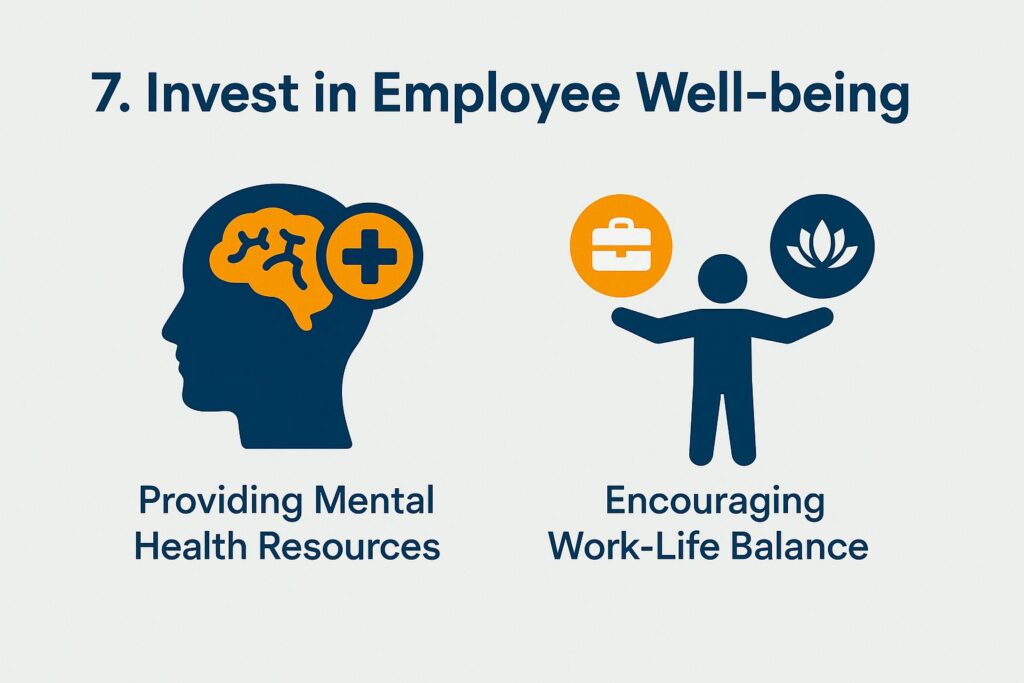
Providing Mental Health Resources
Offering mental health support, like counseling through Talkspace for $49 per week, can greatly improve the help available to employees.
Implementing regular mental health days can help reduce burnout, allowing employees to recharge. Companies like Google and Cisco encourage these practices to promote well-being.
Including mental health training for managers can help create a supportive environment. Tools like Mental Health First Aid or online workshops can equip leaders with the skills to identify signs of distress in their teams.
Creating Employee Assistance Programs (EAPs) provides private counseling and resources, ensuring employees always get the support they need.
Encouraging Work-Life Balance and Employee Wellness
Allowing employees to balance their work and personal life with flexible schedules can increase job satisfaction by 40%, resulting in more employees staying at the company.
To achieve this, companies can implement remote work policies that allow employees to manage their schedules.
For instance, using a hybrid model allows employees to work remotely a few days each week. Setting aside specific days for mental health can create a more balanced environment. Research shows that 76% of employees get more work done after taking days off for their well-being.
By investing in tools such as Slack for communication and Asana for project management, organizations can support their teams effectively while promoting an inclusive work culture.
8. Prepare for HR Compliance and Legal Compliance
Getting ready for legal compliance is important to avoid fines and create an equitable workplace. Understanding how outsourced HR management can support anti-bullying policies can be a crucial step in fostering a respectful environment.
Staying Updated on Labor Laws
Staying updated on labor laws requires regular training sessions and resources, ensuring HR teams are informed of changes.
To effectively implement this, consider subscribing to updates from reputable sources like the Society for Human Resource Management (SHRM) or local government websites.
Regularly schedule training sessions, at least quarterly, that focus on recent legislative changes and implications for workplace policies.
Use online training sites like LinkedIn Learning or Skillshare for interesting courses on compliance subjects.
Create a central repository for all updates, ensuring easy access for your HR team, which promotes a culture of compliance and readiness.
Conducting Regular Compliance Audits
Regular compliance checks can spot possible legal problems early, helping companies avoid expensive fines.
To manage compliance audits effectively, start by establishing a checklist that includes:
- Reviewing policies and procedures
- Evaluating risk management strategies
- Ensuring regulatory adherence
Next, schedule audits on a quarterly basis to maintain oversight. After finding any compliance issues, focus on fixing them according to their seriousness and effect.
For example, if a privacy policy is outdated, update it right away and make sure all staff are taught the new procedures. This proactive approach reduces risks and encourages compliance within the organization.
Recap of Key Strategies
Going over the main approaches, using new technology and encouraging workers to participate are essential parts of good HR management.
To implement these strategies, begin by adopting HR software like BambooHR or Gusto, which simplify talent management and payroll processes.
Invest in tools for employee feedback mechanisms, such as Officevibe or TINYpulse, to regularly gauge morale and engagement.
Establish regular training programs that encourage skill development; platforms like LinkedIn Learning offer a wide range of courses.
By using technology to make operations smoother and encouraging open communication, you can improve both organizational efficiency and how happy employees are.
Looking Ahead to 2025
By 2025, HR will need to respond to new trends, focusing on remote work and employees’ increasing demands for flexibility and well-being.
Organizations should implement flexible work policies, allowing employees to choose their hours or work from alternative locations. For example, a mixed approach of working in the office and from home can improve productivity.
Tools like Slack and Asana can facilitate communication and project management effectively in such arrangements.
Focusing on mental health is important; using resources like employee help programs (EAPs) and wellness apps like Headspace can demonstrate care for employee well-being.
Keeping communication open for feedback is important to keep up with changing employee needs.
About the Author
Ellen Westbrook is a Stanford University graduate with a bachelor’s degree in human resources and psychology. She’s the owner of a successful HR and payroll outsourcing firm in Colorado and a contributing writer for HR Costs. With 17 years of experience, Ellen helps businesses reduce risk, manage HR more efficiently, and grow with confidence.

